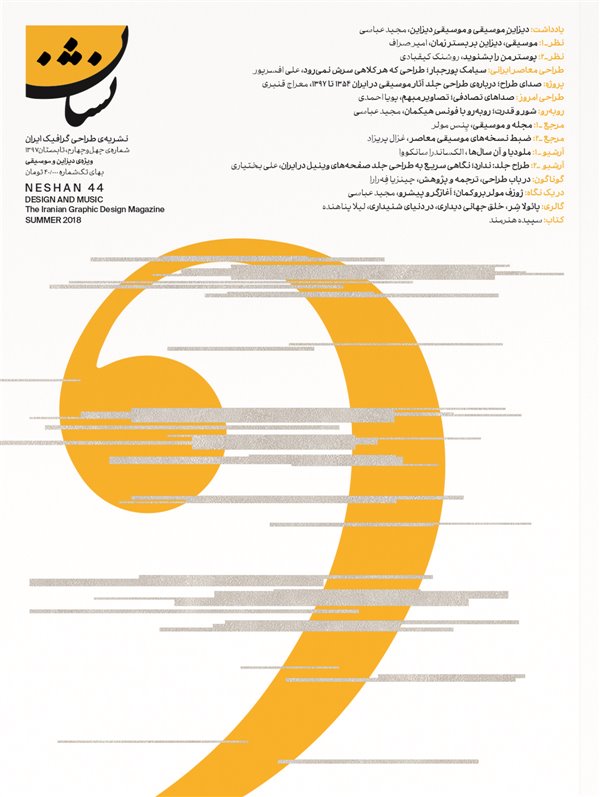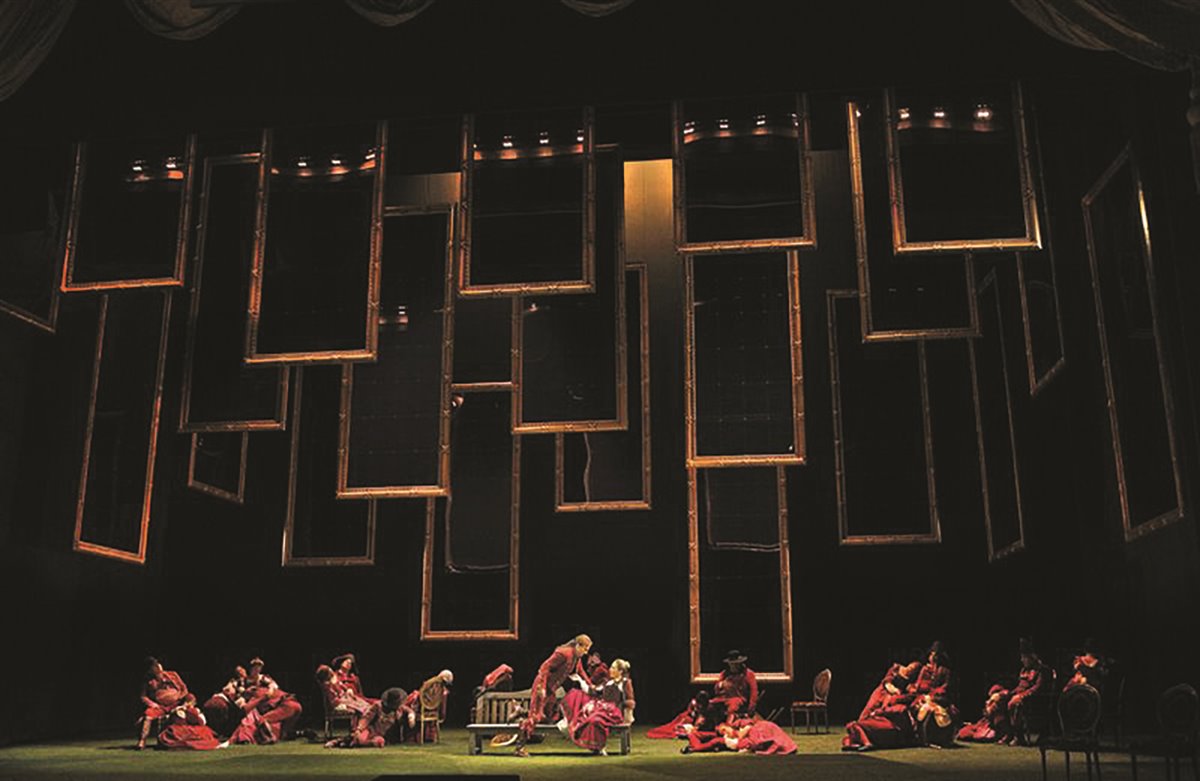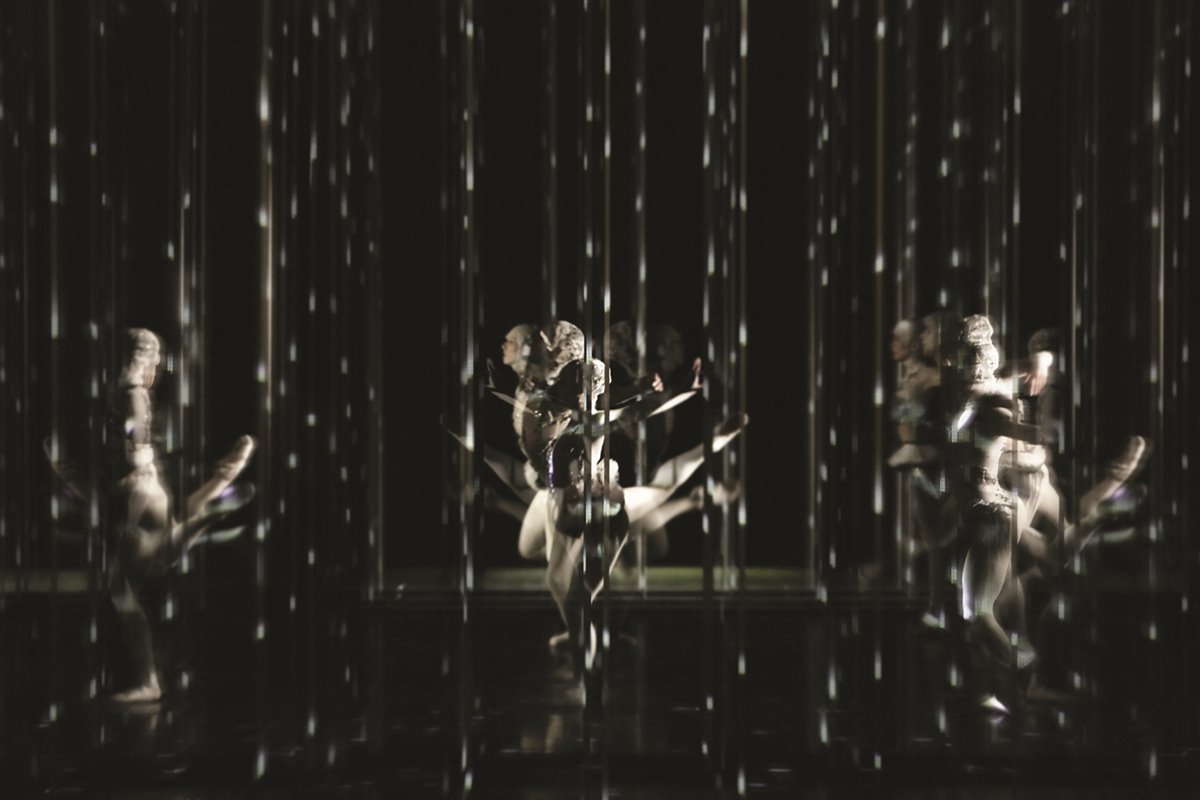Neshan 44

Opinion-I
Music: Design Within The Context Of Time
Amir Sarraf
Design translation may be interpreted as the process of shaping dreamed-up ideas that should be concretized. Hence, a design distinguishes itself from conceptual idea and is deemed constructive or functional. Since the dawn of human evolution and civilization, life has been interwoven and characterized by its objectivity (or materials) designed with industrial, scientific, and artistic rationales. The artistic and functional dimensions of a design shall never be considered inferior to the enthusiasm and taste of the industrial and scientific areas. They manifest most effectively in the constructive arts such as graphic design, product design, architecture, and music. This notion is the core of this article. The author asserts that an attempt at searching for and finding design elements shared by the visual arts and music eventually illustrates the notion of design in music and its hidden manifestations.
 Don Giovanni, Peter Mussbach
Don Giovanni, Peter Mussbach
 The Nutcracker, Yoko Seyama
The Nutcracker, Yoko Seyama
Evidently, by “music” we are referring to classical music, its construct, and its performance. Richard Strauss (1864 –1949) said, “Architecture is the silent music.” It is vastly believed that a piece of music is solely the fruit of inspiration and the genius of the composer, yet there is no knowledge of the determinants of its composition. As no architectural work may be actualized without a design, a detailed plan, and a functional strategy, the composition of music cannot take place without a touch of thought and design. A design may be fully developed in an artist’s mind and unveiled on paper, or it may evolve over time during the composition.
When the first notes of a musical idea or motive is created in the composer’s mind or by an instrument, the design of that idea is produced concurrently and challenges the composer to develop it. This challenge aims to concretize the idea most properly, and demonstrate its large and small features. This is the difference between the great works of music and the banal works. This is because a creative and genuine composer can use his mastery to create the best features and forms for the musical content — even if the theme of the work lacks potency. On the other hand, an inefficient composer can ruin a powerful subject with an improper design. Hence, a composer must be a true designer by virtue of his genius, knowledge, and experience.
In the Oxford Encyclopedia, the simplest definition of form in music is as follows: “It is the construct and design of a musical piece”. In a broader sense, form in music is a construct that not only unveils the visage of music (through sonatas, symphonies, suites and etc.) but also mirrors the order of the musical components. Without a construct and design, music is a formless mass of sounds that fails to pursue an aesthetic goal and brings about utmost satisfaction, excitement, and climax to the audience. Therefore, it fails to improve the hearing and musical experience of the audience.
A musical construct consists of large and small elements, and each element delivers a function similar
to the body parts of a living organism. In music, a design includes the creation of each element and establishment of the best relationships between those elements for a supreme goal. These elements may be described
as follows.
- Melodic design: The unique thematic pattern that has never been heard before and consists of two characters with intervals between the theme notes and arhythmical pattern.
- Homophonic and polyphonic design: The relation between the musical lines or voices with an harmonic or contrapuntal design (or both), depending on the formal needs of the piece.
- Formal design: Determines the overall form of a piece or façade, and explains the relationships between the above elements so that a unique musical perspective is offered.
How is it possible to discuss design in music without discussing the greatest composer and musical designer of all time, Ludwig van Beethoven? He not only changed the institution of design but also reshaped all of the components of music. While preserving past musical values and tradition, he paved a new way for future composers and music that cannot still be avoided. Using his genius and innovative knowledge of all musical elements and components (from the role and function of motifs to a fundamental evolution of the sonata form) he left unique footsteps that are manifested in his masterpieces. He also played a major role in developing the dynamic dimensions to reveal and enhance the potential of instruments. Beethoven’s many other achievements lie beyond the scope of this article. Among his most distinctive masterpieces are 9 Symphonies, 32 piano sonatas, and 16 string quartets. These reveal why he will remain peerless in the history of musical W
Unlike the visual arts, the construct of music is not visible. It does not take up space, and it cannot be calculated and measured geometrically. Music is defined and recognized in the time domain, and it can be perceived within the ongoing context of time. Therefore, music can be considered a design within the context
of time.
So far we have explained constructive musical design. Now it is time to describe the functional musical design that can be called “performance”. The “design in performance” phrase immediately evokes notions such as stage design, costume design, and motion design. However, it must also be noted that our discussion of the composition of a piece of music must also include the musical performance of that piece. The collection of these notions is called “musical interpretation”. A great performer of music (i.e. a player, singer, or conductor) is obliged to have a comprehensive knowledge of all dimensions of the piece and perform all of the mentioned dimensions in the best way possible. Hence, a musical performance can be described as design in motion or time. There are numerous performance design differences between the various performances of a piece of the music staged by the great musical performers, and these differences give birth to the authenticity and beauty of musical performances.
The elements shared by visual and musical designs shall be sought in certain forms known as «composite arts». Two of the most original and distinctive composite forms are opera and ballet. An opera is a musical drama that benefits from the combination of several arts such as literature, poetry, drama, stage design, costumes design, acting, and dancing. This combination can also be found in the art of ballet, which is free of words and it values the art of dancing and choreography that shine beside music. This is where the designer’s job begins. For instance, design starts with stage design, which must fully comply with the form, content, and style of the given work and must display it in the best way possible. It may also start with the design of other necessary dimensions. Ostensibly, this link has existed throughout the music history and has transformed over time to adapt to the time of the works of art. Accordingly, there are great designers that sometimes touch the classic works with their abstract and contemporary designs and change and express their scenes using the modern language in a fully abstract form. Among the best examples of these alterations are the different performances of Mozart’s Don Giovanni conducted by Daniel Barenboim and directed by Peter Mussbach (also the stage designer) or Tchaikovsky’s The Nutcracker performed by a Leipzig Ballet. In the latter performance, the stage was designed by Jean-Philippe Dury, the choreography was carried out by Casse Noisette and the costume design was performed by Yoko Seyama.
Lastly, it should be stated that this article attempted to clear a narrow path to the world of music and introduce the role of design in the musical construct and performance. The ultimate goal was to enable us to understand that hearing, perceiving, and enjoying musical masterpieces from another hidden dimension of the world of music. This goal is not achieved easily and it calls for the ability of not a musician but an audience with the knowledge of arts and auditory experiences that are as vast as the history of music.
Design for Music, Music for Design
Majid Abbasi
> more
Opinion-II
Listen To My Poster
Roshanak Keyghobadi
> more
Iranian Contemporary Design
Why Is A Raven Like A Writing Desk?
Ali Afsarpour
> more
Project
The Designer’s Voice, On Designing Record Covers In Iran, 1975 To 2018
Meraj Ghanbari
> more
Design Today
Indeterminate Sounds; Indefinite Images
Pouya Ahmadi
> more
Face to Face
Power And Passion; Face To Face With Fons Hickmann
Majid Abbasi
> more
Reference-I
The Magazine And The Music
Jens Mueller
> more
Reference-II
Edition Of Contemporary Music
Gazelle Parizad
> more
Archive-I
Melodiya Of Those Years
Alexandra Sankova
> more
Archive-II
Cover Designer: N/A ;A Quick Glance At The Sleeve Design Of Vinyl Records In Iran Ali Bakhtiari
Ali Bakhtiari
> more
Different
Of Designing, Of Translating, Of Searching
Cinzia Ferrara
> more
Overview
Josef Müller-Brockmann; Initiator And Pioneer
Majid Abbasi
> more